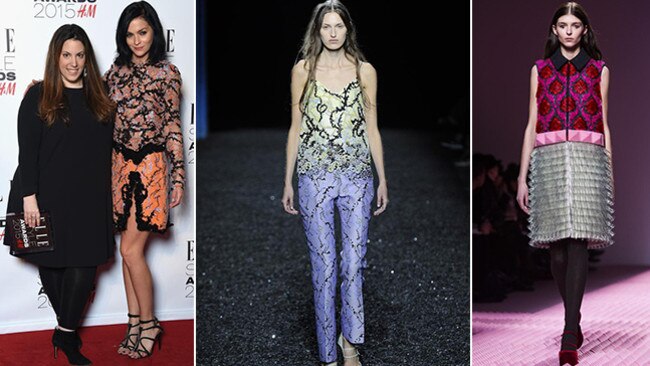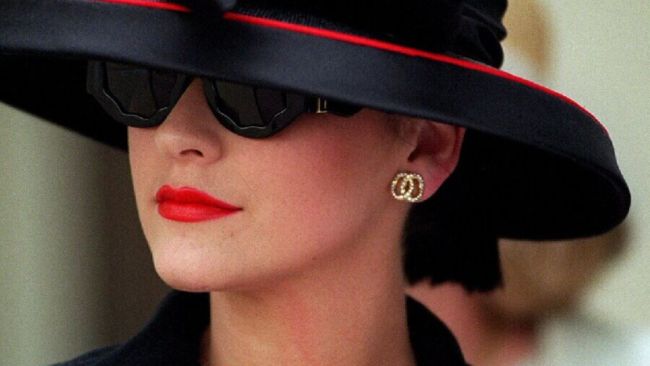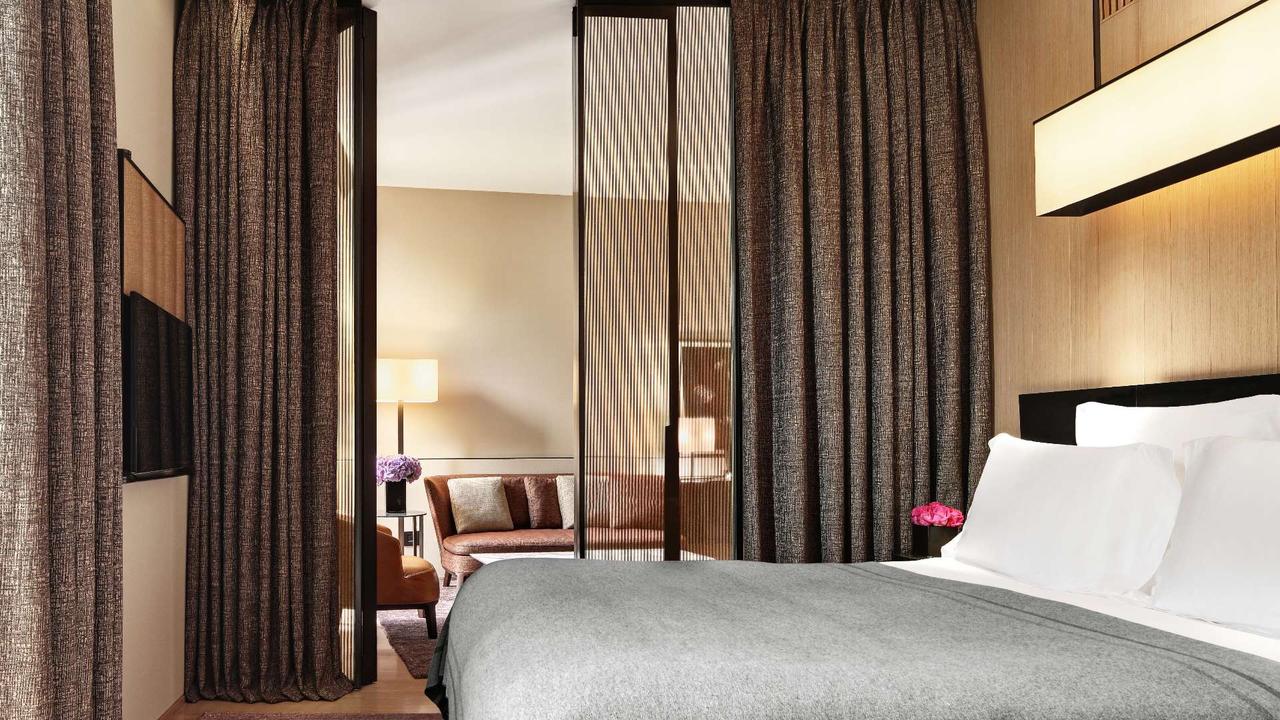Mary Katrantzou knows the difference between luxury and designer
Mary Katrantzou’s pioneering prints spawn countless copies but remain exquisitely out of reach for the masses.

Florals, paisleys and perhaps the odd bird or two. An idyllic pastoral scene, at a push. These are the sorts of things you’d expect to find printed on women’s clothing.
But peer at one of Mary Katrantzou’s dresses and you’re more likely to spot spoons, typewriters and postage stamps. Sometimes they’re literally hanging off: her autumn 2012 collection featured thousands of HB pencils carefully stitched on to a skirt by Parisian couture embroiderers Lesage.
If that sounds like too much high-fashion whimsy, consider that Katrantzou’s clothes are some of the consistently bestselling in their bracket at stores such as Selfridges and Harrods as well as online at Net-a-Porter and Matchesfashion. Not only that, they’ve been worn by the likes of Taylor Swift and Sarah Jessica Parker on the red carpet. Proof, if it were needed, that Katrantzou’s clothes have the necessary glamour factor, for all their avant-garde credentials.
And it isn’t only among the A-list that you see her influence — the mass market has leapt on the techniques she pioneered, too. Katrantzou is the designer who made us all wear print. Her digital graphics of unusual objects shaped around the body with multicoloured filters have inspired a thousand high street homages. Meanwhile, her own price tags start at £1000 ($1985) — mostly at £2000, actually.
The 31-year-old Greek designer is unrepentant. She launched her luxury label during a recession and has seen it grow from strength to strength. “I don’t want to be attainable,” she says. “You need to create a distance so that somebody paying the money they’re paying for it feels special.”
We are sitting in an East London showroom, surrounded by Katrantzou’s latest pre-collection: non-catwalk pieces that drop into stores between the traditional summer and autumn seasons (July to be precise). These are usually the more accessible — and accessibly priced — part of a designer’s vision, but that doesn’t mean she has made them any less intricate.
Taking elements from previous collections, such as the stamps and the industrial objects, she has created what she calls her own paisley. It comes as lace trim and inserts here, a monogram there, a blown-up houndstooth pattern, brocade and thick embellishment.
The detail and the craftsmanship, as well as the visual impact, are proof enough of why Katrantzou has one of the biggest followings on Instagram among her designer peers — more than 240,000 people follow the feed from her studio. “A cotton top would be about £300 ($595),” she tells me. “The most expensive piece is about £2000, so it’s still nowhere near how expensive we go in the main collections.”
She is right. I once eyeballed a sequined sweatshirt on her catwalk only to be told afterwards it clocked in at nearly £10,000 ($19,800). My ambitions were duly shelved. “I’m building a luxury brand, not a designer one,” she explains, all smiles and none of the haute sniffiness that often accompanies that sector — even though I seem to keep turning the conversation around to filthy lucre. “That means working with amazing craftsmen. I don’t want to compromise on that.”
Nor does she need to — with more than 200 stockists around the world (including David Jones and a selection of boutiques in Australia), not to mention many more private orders, Katrantzou’s version of luxury ticks plenty of boxes. Yet she doesn’t stand still for a minute, constantly reappraising the aesthetic of her six-year-old label. The prints she has become known and loved for are being phased out, she says. It’s time to move on.
“I took a strategic decision to move away from print. It had to happen. Print has become so democratic everyone is wearing it. The novelty is no longer there. When I started you could print these things that no one had ever imagined wearing.” Hence the extrusions of pencils, crystals, microsequins and, latterly, the filigree-fine lace she has been working with.
From graphics, Katrantzou has built up and out, into 3-D and sumptuous fabrics, to keep her USP as U as ever. At her most recent show in London last February she matched sober hobble skirts in grey felt with brocade parkas, each decorated with pyramids of the pink foam that made up the catwalk. “What we were doing with print I tried to do with lace and embroidery and that’s why the prices had to go as high as they did,” she says. Nobody seems to have minded, I offer in return, and she laughs.
Katrantzou grew up in Athens, the daughter of a businessman and an interior designer. “That was my training,” she tells me. “I was brought up around design and the focus on objects became a bit of an obsession.” She first studied architecture at Rhode Island School of Design in the US but switched to fashion at Central Saint Martins, where she completed her bachelor of arts and then her masters, the latter under the tutelage of Louise Wilson.
“You had to figure out what you wanted to do, who you wanted to be and present that to Louise in a really efficient way,” she says. “She built you up and broke you down and the moment she said, ‘You know, Mary, this is something I’ve never seen before’, you knew it was good.”
In 2008, only a season after graduating, Katrantzou was picked up by Topshop’s Newgen sponsorship scheme to present a collection of eight dresses during Fashion Week. The buyers who saw them were instantly taken. Katrantzou filled her first order for a boutique in Italy, with further interest from Brown’s, the shop that famously bought up John Galliano’s first collection.
Although she started “bang in the middle of the recession”, Katrantzou believes her initial naivety helped her do well during the downturn. “Things were going super-badly, but I didn’t really realise. What I was doing was new and people wanted new. Newness is the No 1 driving factor in fashion.”
She was so new that she found it difficult to fill all the orders placed and struggled to fund her next collection, which was crucial to maintain the interest piqued by her first. She had no idea whether momentum would keep up so didn’t hire anyone. Her team now, still relatively small, has filled out somewhat and the label keeps Katrantzou busy. Unlike many it is self-funded, without investment from backers or stakeholders.
“I have been cautious,” Katrantzou says. “We still feel we are trying to run so fast, but I have people I can rely on. I go to them for advice. I have the sort of relationship where I can go and ask them what they think about this and that.”
Ruth Chapman of Matchesfashion is only too happy to sing Katrantzou’s praises: “From the beginning I’ve loved what Mary does on two levels — her prolific creativity, but also her business acumen. She knows how to take her brand to the next level, evolving while maintaining a strong DNA. She was obviously going to become a star.
“Women collect her pieces like they do art,” Chapman says, and it isn’t only the upper tier who can afford to. In 2012 Katrantzou worked with Topshop on a capsule that became one of the fastest selling in the brand’s history of designer collaborations, even though the label was only two years old.
Last year she launched a collection of sportswear for Adidas — tennis dresses panelled with blown-up details from training shoes, trainers that featured techy mesh prints and blossoming flowers. Pieces cost a tenth of her main line. It’s a partnership she sees a future in, she says.
“It’s cool for somebody in their teens to wear Mary Katrantzou when they can’t afford [the main line]. Each collaboration brings awareness. Part of the reason I started doing them is because my work became distinct enough for people to copy it.”
She has contemplated lawsuits against large high street chains, she tells me, but they take too long and aren’t worth it. “I was upset — now I know it’s just the way the fashion cycle works. It’s a compliment.”
Australian stockists: https://www.marykatrantzou.com/stockists/australia


